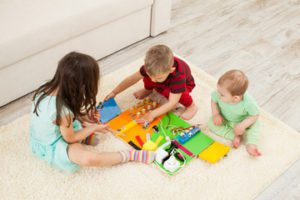Sensory Boards and the Importance of Play
by Sarah Koppenhoefer-Little, MS, OTR/L
Kids Place Pediatric Occupational Therapist
One of the main jobs or “occupations” of a child is to play. As they play, they learn about their environment, gain essential skills, and have a fantastic time doing it. The poet Diane Ackerman once said, “Play is our brain’s favorite way of learning.” For instance, a child will learn about gravity by pushing a toy off the table and onto the floor. This playful game will make most infants and toddlers giggle with glee. They learn by watching the toy fall (visual sense), listening to the loud BANG (auditory sense) and finding pure joy of doing it countless more times (motivation and repetition).
The sensory systems include sight (visual), hearing (auditory), touch (tactile), smell (olfactory), taste (gustatory), balance (vestibular), and body awareness (proprioception). Children need to have many different sensory experiences throughout the day for their brain to accurately take in the information, organize it and finally use it to participate in functional activities. Repeated exposure to a wide variety of experiences is key to helping their systems integrate appropriately. This needs to occur so the child will eventually be able to do things on their own like walk, open a container, write, participate in self-care skills, prepare food, play sports, and manipulate the world around them.
In order to help their systems modulate and adapt, they require an assortment of multi-sensory experiences. If a child misses out on play during the early stages of life, they can develop difficulties with gross motor skills (big movement and coordination of arms, legs and other body parts) and fine motor skills (movement and coordination of small muscles, hands and fingers). There are many ways to facilitate play through multi-sensory experiences at home.
Sensory boards are a great tool to use, because they can be custom fit to each individual child’s needs inexpensively and efficiently. All you need is a piece of wood (plywood is a cheap and easy option) and some creativity. Adding a variety of textures such as rough, smooth, soft, and bumpy is a good way to include tactile play. Your local home improvement store will offer free carpet samples, plus you can use things around the house like sponges, feathers, foil, buttons, dried beans/rice/pasta, etc.
Other options for the board can be things to push/pull, twist, and open/close. This will strengthen hand muscles that are necessary for fine motor skills, plus help with eye-hand coordination. There are a wide variety of latches, hooks, locks, containers, and switches that can also be found at a home improvement store. Additionally, you can add components that will make noise, light up, and or have different smells. You can even have multiple boards showcasing different skills. The options are endless when it comes to making a unique sensory board. Likewise, the child will be motivated to spend hours playing and learning, rather than spending hours on ‘screen time.’
The first time a child touches a rough, sticky, or slimy texture will be a learning experience. Some children may like it and others may not and will cry or wipe it off immediately. When their sensory systems are sensitive to tactile experiences, they receive an adverse effect. If this effect interferes with their daily life, an evaluation from an occupational therapist (OT) may be necessary. The OT can provide a safe environment for the child to habituate to the off-putting stimulus and eventually become active members in their own life.








